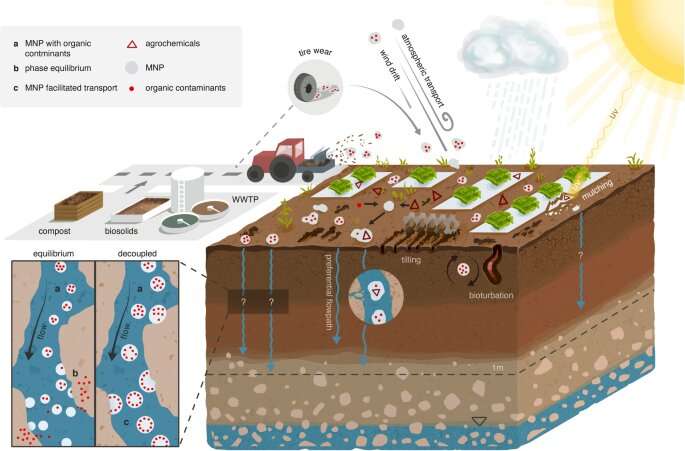Microplastics do not contribute to the mobility of organic pollutants in agricultural soils

In agriculture, large quantities of nano- and microplastics end up in the soil through compost, sewage sludge and the use of mulching foils. The plastic particles always carry various pollutants with them. However, they do not transport them into the groundwater, as is often assumed. Environmental geoscientists led by Thilo Hofmann have now determined that the plastic particles release the pollutants in the upper soil layers: they do not generally contaminate the groundwater, but have a negative effect on soil microbes and crops. The study by the University of Vienna appears in Nature Communications Earth & Environment.
Pollutants enter agricultural soils with plastic particles
Wastewater and rivers carry microplastics into the oceans. Wind distributes the particles to the remotest parts of the earth. However, agriculture itself plays a far greater role in plastic pollution of agricultural land: fertilizers such as compost manure or sewage sludge and the remains of agricultural mulching foils carry large quantities of plastic particles, so-called macro-, micro-, and nanoplastics, onto agricultural land. According to current estimates, for example, with every kilogram of sewage sludge, up to 300,000 plastic particles end up on agricultural soils—and with them pollutants. "Plastic always contains so-called additives. These additives ensure certain properties, durability or even the color of a polymer. In addition, contaminants such as pesticides or pharmaceutical residues may become adsorbed to the plastic particles," explains Stephanie Castan, lead author of the study and Ph.D. student at the Centre for Microbiology and Environmental Systems Science (CMESS) at the University of Vienna.
Common assumption that microplastics carry pollutants into groundwater challenged
"The plastic particles eventually release these pollutants into the environment. We were interested in when exactly they do so," adds Castan. The research team reviewed the common assumption that the plastic particles could transport the pollutants all the way to the groundwater—and they came to a clear conclusion: "Our calculations show that they generally don't do that," says Thilo Hofmann, head of the study and research group. "The pollutants remain in the upper layers of the agricultural soil because they are already released there by the polymers."
Calculation of transport and desorption time for different scenarios
Whether pollutants can migrate to groundwater by means of micro- and nanoplastics depends on whether the transport of the plastic particles through the soil layers is faster than the release (desorption) of the pollutants from these particles. For the study, the researchers therefore focused on these two key figures—the transport time and the desorption time—and calculated the so-called Damköhler number: the Damköhler number expresses the ratio of the two key figures. "In order to be able to make clear statements about the conditions under which plastic particles actually serve as transport facilitators for pollutants, we calculated the Damköhler number for two extreme settings—the usual agricultural soil and a more fractured rocky soil," reports Charlotte Henkel, co-first author of the study. "We also took into account different properties of plastics and contaminants."
Data show that plastic particles do not increase the mobility of pollutants
Comparing the calculated scenarios to measured data from literature, the researchers found no evidence that nano- and microplastics are significant carriers for pollutants. "The fact that plastic particles increase the mobility of pollutants in the soil is only plausible for very specific polymers and specific soil conditions, for example when soils are severely dried out and washed out by heavy rain," explains Thorsten Hüffer, environmental chemist and co-author of the study. Contamination of groundwater by this means is therefore unlikely, he says. "However, we are by no means saying that nano- and microplastics in agricultural soils are harmless," emphasizes Thilo Hofmann, who, as head of the PLENTY research platform and the Environmental Research Network at the University of Vienna, promotes interdisciplinary research on plastics in the environment. "Rather, we are showing where the real problem of these pollutants bound to plastic particles lies: they do not end up in groundwater, but in the upper soil layers. Here, they can potentially be taken up by crops and microorganisms and subsequently also enter our food."
Follow-up study to clarify whether plants absorb pollutants from soil
The study thus provides good news for groundwater, but rather bad news for agricultural crops: The Environmental Geosciences team will conduct a follow-up study to determine whether crops can actually absorb the pollutants through the soil. In a laboratory beaker on her desk, Stephanie Castan is already growing three lettuce seedlings for the upcoming experiments.
More information: Stephanie Castan et al, Microplastics and nanoplastics barely enhance contaminant mobility in agricultural soils, Communications Earth & Environment (2021). DOI: 10.1038/s43247-021-00267-8
Journal information: Communications Earth & Environment
Provided by University of Vienna





















